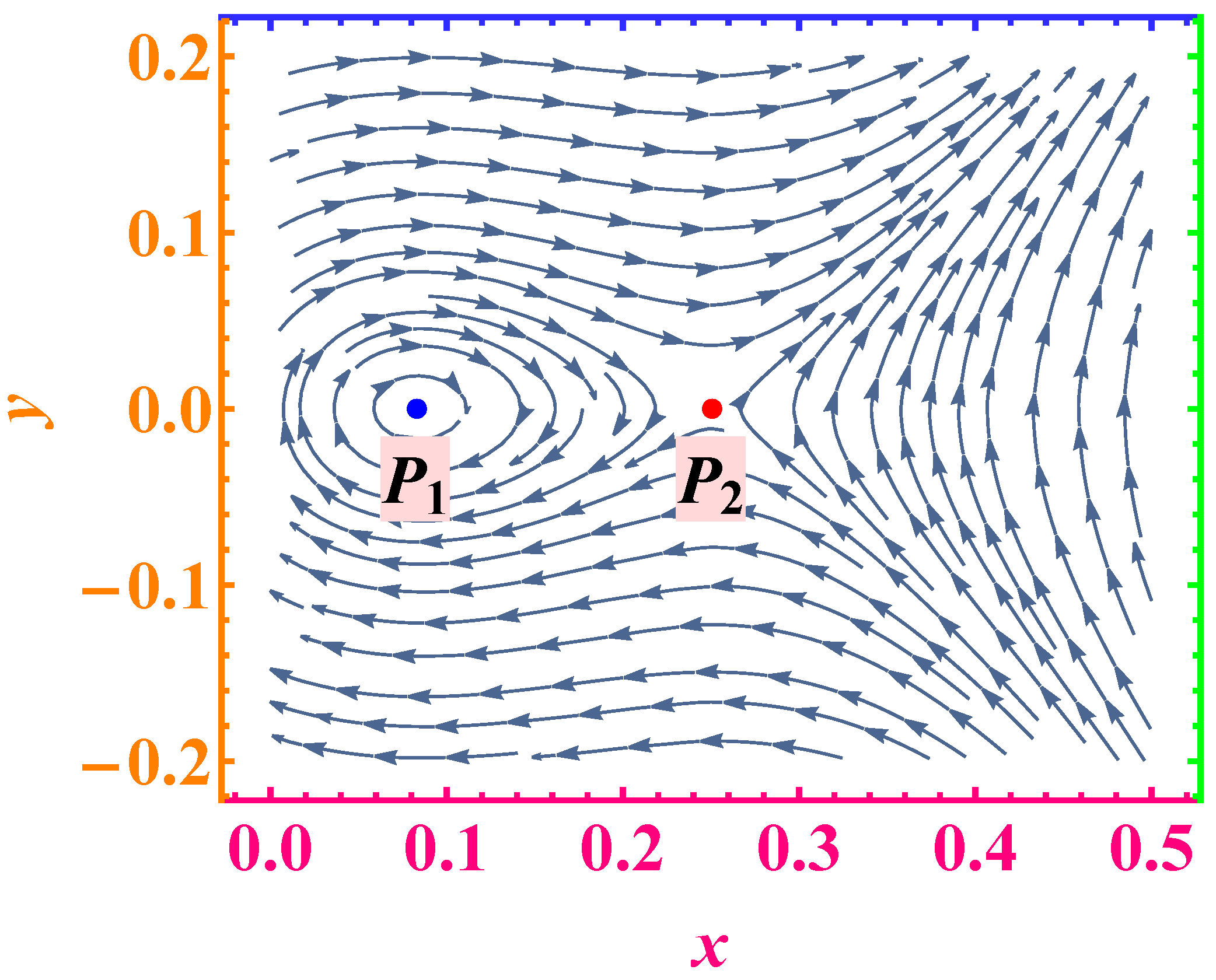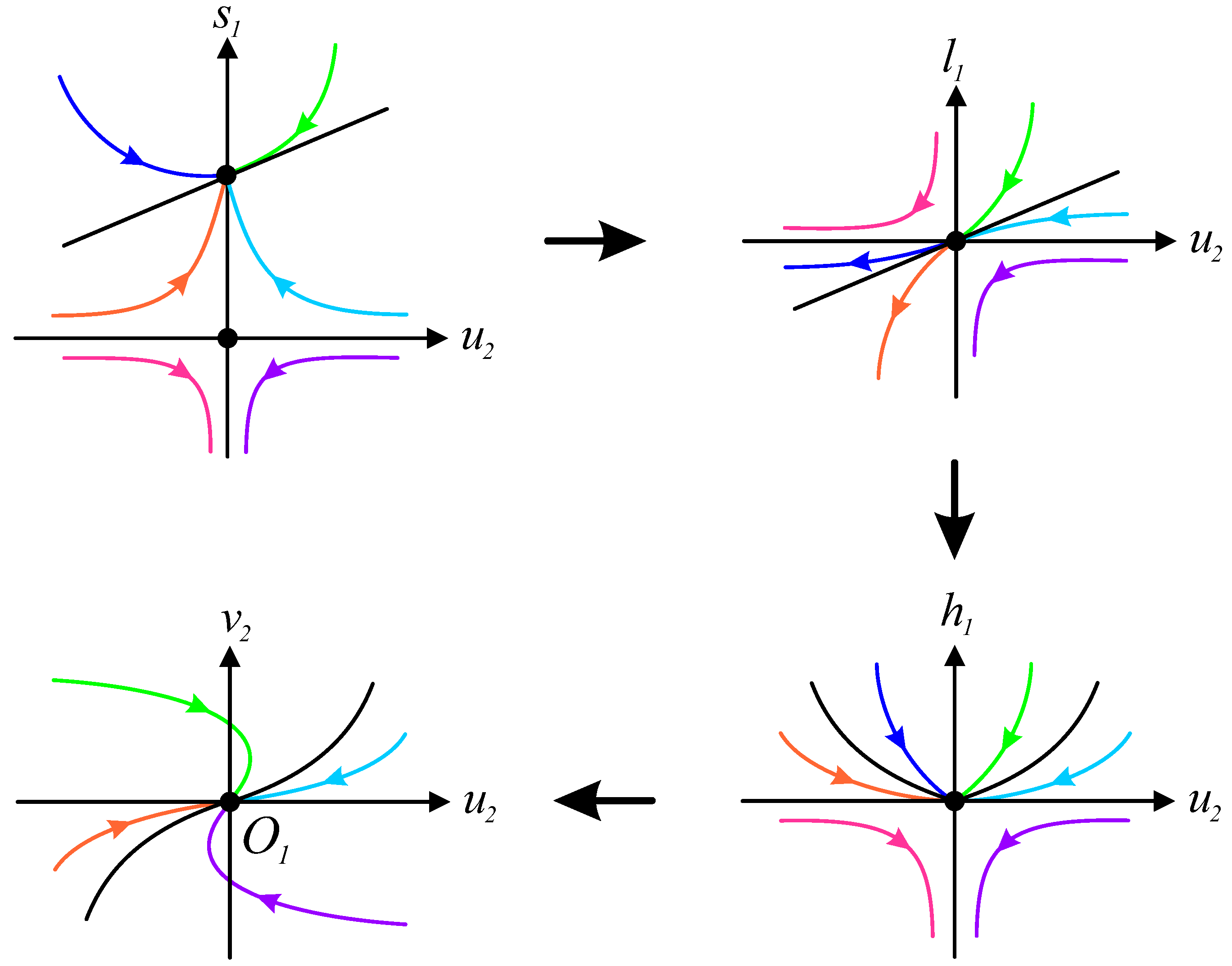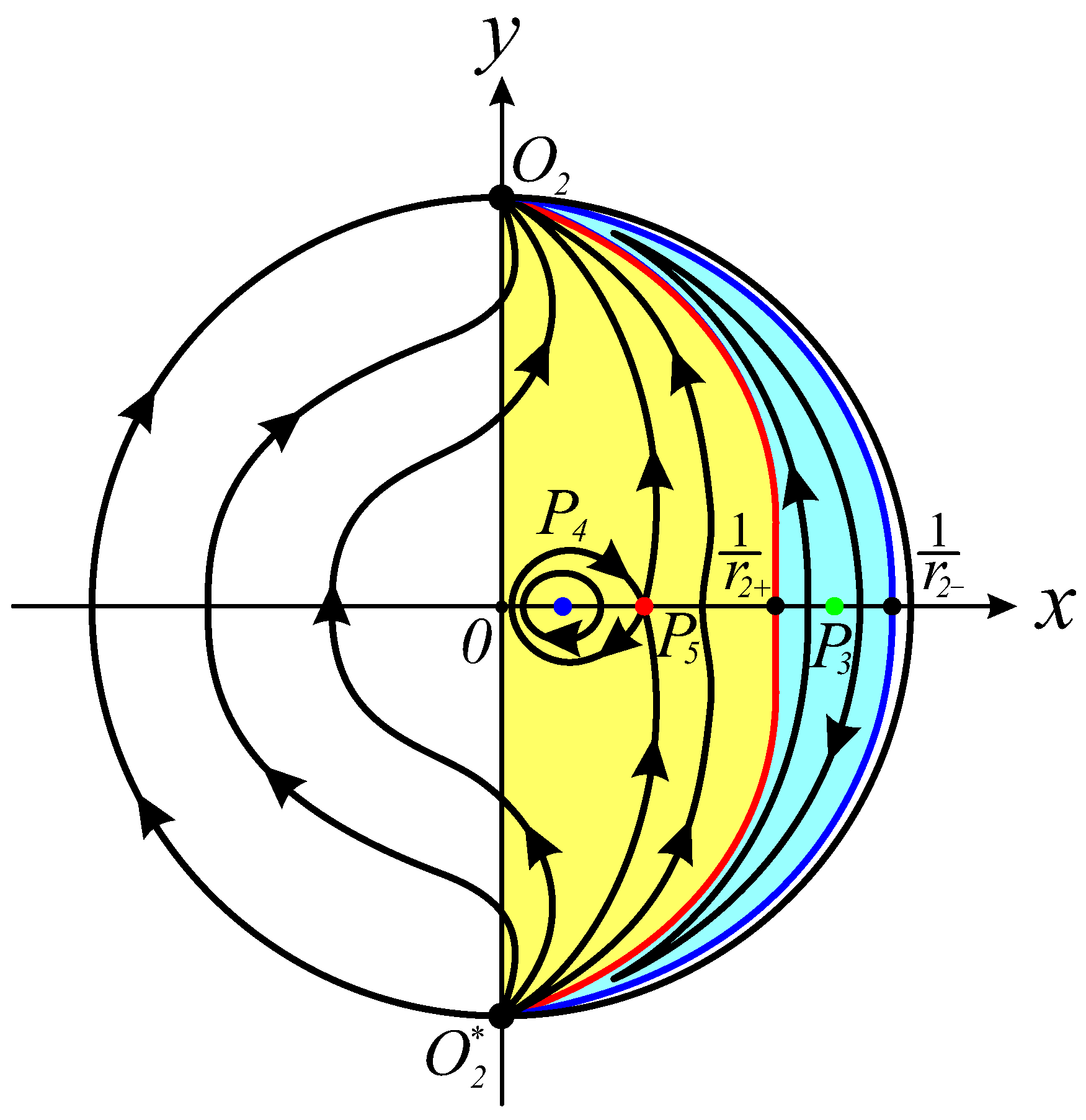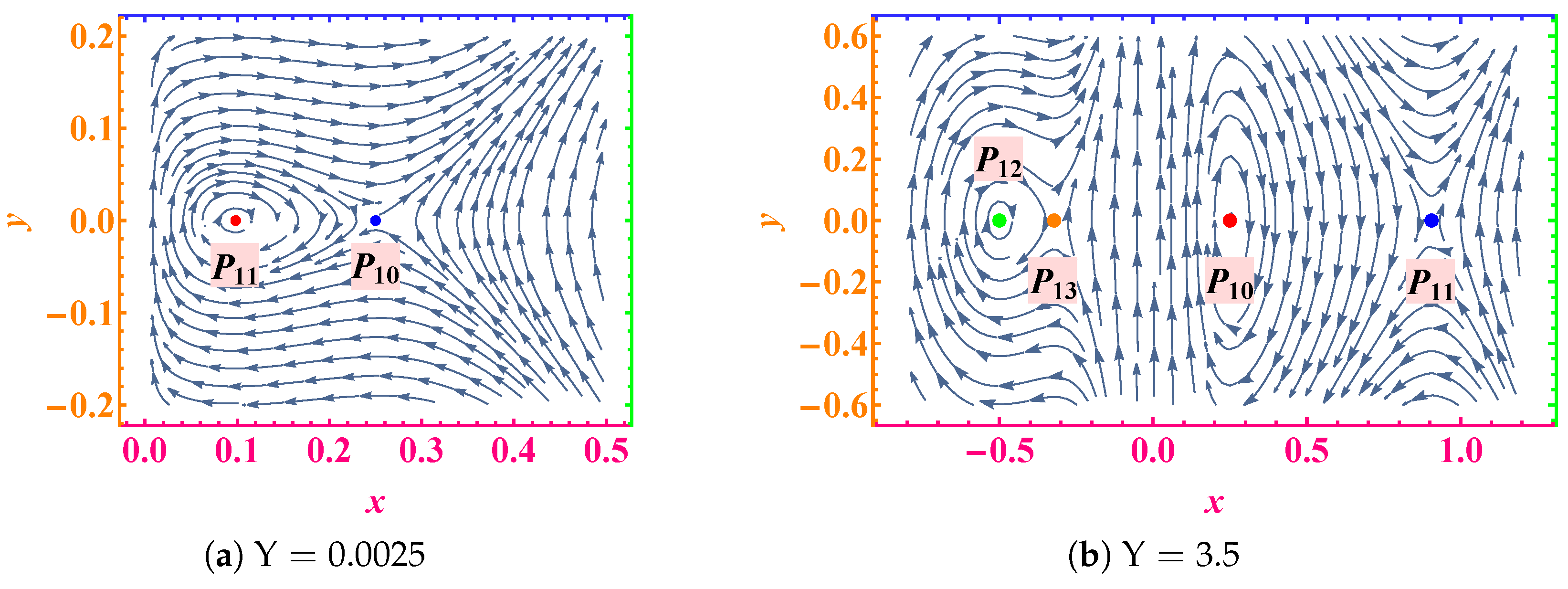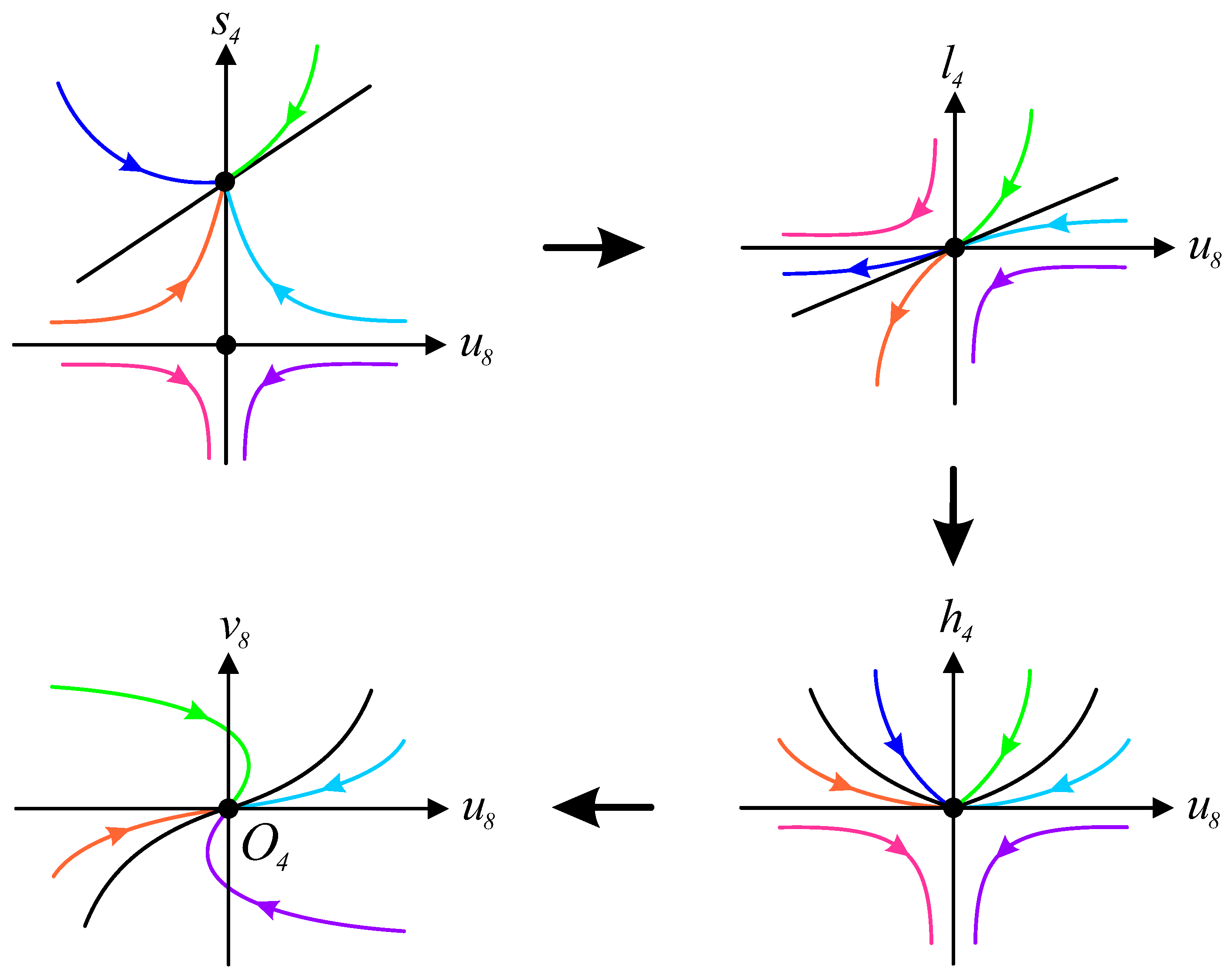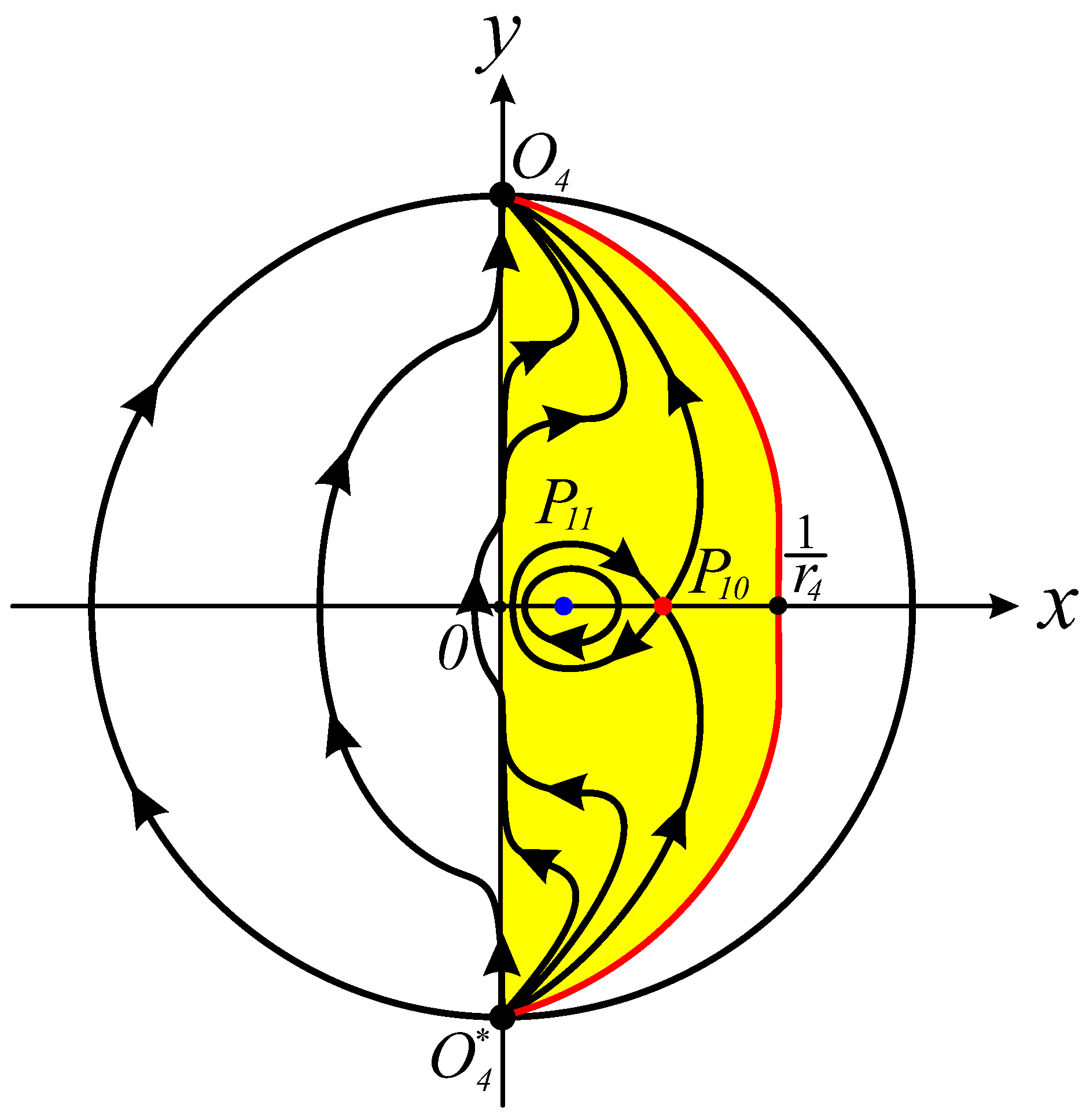Considering a static and spherically symmetric vacuum spacetime solution for the action (Equation (
3)) given by
we can obtain a power-law hairy black hole with the form [
22,
26]
where
denotes the Schwarzschild radius, with
and
serving as the Lorentz-violating parameters. The parameters
and
are Lorentz-violating parameters derived from the breaking of local Lorentz symmetry in a spherically symmetric black hole spacetime, which is driven by the vacuum expectation value of a Kalb–Ramond field (see reference [
22] for more detail). The scaling exponent
regulates Lorentz violation scale dependence. While the mathematical framework permits Lorentz violation strength parameter
for theoretical consistency, as physical considerations impose stricter constraints. In realistic scenarios,
must not only be non-negative but also sufficiently small, typically bounded above by
(see [
27]), to align with observable physical scales or phenomenological limits. Such parameters generally exhibit extremely small magnitudes, though their exact bounds may vary across different physical contexts (see [
28]).
For a timelike particle, we introduce the substitution
and define
. The equation of motion can then be expressed as
which can be transformed into an autonomous dynamical system
where the dot “·” denotes differentiation with respect to
and
represents the dimension of the non-minimal coupling constants in the self-interacting KR field. The parameter
governs the magnitude of Lorentz violation effects on the Schwarzschild solution.
In the subsequent analysis, we set
(which implies
) and
, and then investigate the global dynamics of System (
7) by varying
and considering four values of
: 2, 1, 2/3, and −2. The relatively high angular momentum
is chosen to prevent the particle from approaching the black hole too closely, where nonlinear terms dominate and the probability of chaos is high. As different values of
may correspond to distinct LV patterns or specific mathematical structures within the theory, we adopted the special values
and
, as used in [
26]; to ensure generality, we further included
and
, aiming to explore how variations in
affect the system’s dynamical behavior. The same analysis can be applied to the case of null particles, i.e., System (
9).
2.1. Case I:
For the case where
, we analyze the equilibrium states of System (
7) by setting
and
. This yields two finite equilibrium points:
These equilibrium points are real and distinct when the parameter
satisfies
or
. The local stability of these equilibrium points can be examined through the Jacobian matrix of System (
7):
where
is the equilibrium point of System (
7).
By substituting the coordinates of the equilibrium points
and
into the Jacobian matrix
J, we obtain their respective eigenvalues:
where
denotes the imaginary unit. The eigenvalue analysis reveals that
The equilibrium point
corresponds to the outermost stable circular orbit (OSCO), which refers to the largest radial distance from a black hole at which a test particle can maintain a stable circular orbit under the influence of the black hole’s gravity. Beyond this radius, additional external forces (such as those from a surrounding matter distribution or a dark matter halo) may dominate over relativistic orbital stability. Point
corresponds to the innermost stable circular orbit (ISCO) of the black hole, i.e., the smallest stable circular orbit that a test particle can maintain around a black hole without spiraling inward due to gravitational radiation or instability. Within the innermost stable circular orbit, the massive particles will quickly fall into the black hole. It marks the boundary between stable and unstable circular geodesics in the black hole’s spacetime.
Figure 1 illustrates the corresponding phase portrait of System (
7) in the finite plane.
The behavior at infinity characterizes the limiting properties of physical systems and mathematical solutions as spatial coordinates approach infinity or temporal evolution tends to infinity. In dynamical systems, this asymptotic analysis determines solution behaviors through three fundamental scenarios: (i) convergence to attractors (stable equilibria), (ii) divergence with unbounded growth, or (iii) persistent oscillations manifesting as cycles. To analyze the behavior of System (
7) at infinity, we employ Poincaré compactification [
29,
30], a powerful analytical method in dynamical systems theory that enables the study of polynomial vector fields at infinity by projecting the phase space onto a compact manifold, typically a sphere or a hemisphere, through stereographic projection. By employing local coordinate charts (e.g.,
and
) with transformations, this technique regularizes dynamics at infinity, allowing infinite trajectories to be analyzed as finite points. The method incorporates time rescaling and vector field normalization to preserve smoothness, thereby permitting standard tools like linearization and stability analysis to be applied to equilibria at infinity. Notably, Poincaré compactification provides a unified framework for characterizing both finite and infinite dynamics, revealing topological invariants and bifurcation structures essential for understanding a system’s global dynamic behavior while maintaining consistency with local flow properties near the boundary of the compactified space.
First, we consider the local chart
through the following transformation:
which converts System (
7) to
In this formulation, points with
correspond to points at infinity in the original system (System (
7)). However, System (
10) possesses no equilibrium states satisfying
, prompting us to examine the local chart
instead.
On the local chart
, we transform System (
7) using the coordinates
,
to obtain
The point
in System (
11) corresponds to the remaining infinite equilibrium points of the original system (System (
7)) that were not captured by System (
10). It indicates radial infinity of the black hole. Clearly,
is an equilibrium state of System (
11) and thus represents an infinite equilibrium state for the original system. However,
is a degenerate point, as both eigenvalues of its Jacobian matrix vanish.
To analyze the local trajectory structure near
, we employ the blow-up technique [
31]. This technique is a fundamental method in dynamical systems theory for analyzing degenerate singularities (e.g., higher-order singularities or nilpotent singularities). Its core concept involves using geometric transformations to “magnify” the singularity into a higher-dimensional manifold, thereby decomposing the system’s dynamics into tractable regular components. Here a singularity (alternatively termed an equilibrium point, fixed point, or critical point) corresponds to a state vector where the time derivatives of all system variables vanish identically. This condition implies that the system’s state remains invariant under temporal evolution. Specifically, the method first expands the singularity into a circle or curve on the manifold to eliminate degeneracy, then separates the trajectories into radial and angular dynamics for detailed analysis. Finally, by studying the dynamics on the blown-up manifold, the local phase portrait structure near the original singularity can be reconstructed. This technique is particularly powerful for studying non-hyperbolic singularities, nilpotent vector fields, and other challenging cases.
The characteristic polynomial of System (
11) is given by
where
and
represent the homogeneous polynomials of degree
m (the minimal degree in System (
11)) corresponding to the
and
components, respectively. For System (
11), we specifically have
and
.
This analysis reveals that
is the unique characteristic direction at the origin. To resolve the singularity, we perform a
-directional blow-up transformation, where
which yields the following desingularized system:
For the case when
, System (
12) exhibits a single equilibrium
with eigenvalues
, necessitating a secondary blow-up transformation. The characteristic polynomial
suggests the characteristic direction
, prompting the directional blow-up of
↦
, where we factor out
to obtain the following transformed system:
The persistent degeneracy at
with eigenvalues
and characteristic polynomial
motivates a third blow-up via
, yielding
System (
14) exhibits two non-degenerate equilibria with the following characteristics:
- (1).
: Eigenvalues , with
- -
A saddle point for all .
- (2).
: Eigenvalues , yielding
- -
A stable node when .
- -
An unstable node when .
Although in experimental implementations and physical applications, is typically constrained to a very small non-negative value () to reflect real-world physical conditions, in this theoretical framework, we allow to vary widely to ensure the system’s mathematical consistency.
Through systematic reversal of the blow-up transformations (as illustrated in
Figure 2), we reconstruct the original system’s phase portrait.
Figure 2 specifically demonstrates this process for the parameter value
, which has been previously investigated in [
22]. The complete dynamical behavior of System (
7), incorporating both finite and infinite analyses, is presented in
Figure 3, and the corresponding equilibrium points are summarized in
Table 1. In this graphical representation,
signifies the black hole’s event horizon when
and
, with the red curve establishing a bijective mapping from the physical domain
to the compactified coordinate
through the inversion transformation
.
2.2. Case II:
For
, System (
7) possesses three finite equilibrium points:
where the algebraic expressions for
,
and
are provided in
Appendix A. The existence conditions for these equilibria are as follows:
exists for all parameter values.
and are real when .
and coincide at (bifurcation point).
The eigenvalues for each equilibrium
(
) are given by
Stability analysis reveals that when it is hyperbolic,
and
are centers, and
is a saddle point for
. The equilibrium point
is located between the inner and outer event horizons of the black hole. Point
corresponds to the outermost stable circular orbit of the black hole, while
corresponds to the innermost stable circular orbit.
Figure 4 illustrates the finite phase plane of System (
7) for
and
. Due to the significant spatial separation of
from the other equilibria, the phase portrait is presented in two panels for clarity. Remarkably, the trajectories surrounding the point
exhibit an exceptionally narrow closed configuration, characterized by opposing directional orientations on either side that ultimately converge at an extremely distance from
. This distinctive topological feature arises from the presence of either a distant equilibrium point or an asymptotic attractor.
To investigate System (
7)’s dynamical behavior at infinity, we employ the Poincaré compactification method. On the local chart
, we introduce the following coordinate transformation:
which transforms System (
7) into
The transformed system (System (
15)) satisfies
when
, since
This implies that System (
15) admits no equilibrium points on the line
in local chart
. Consequently, the original system (System (
7)) possesses no equilibrium points at infinity in this local chart.
Similarly, on the local chart
, the coordinate transformations
and
transform System (
7) into
This system admits the equilibrium state , which corresponds to the infinite equilibrium state of the original system. In black hole spacetime, it indicates radial infinity. However, is a degenerate point, as both eigenvalues of the Jacobian matrix vanish. To analyze the local dynamics near this singularity, we employ the blow-up technique.
The characteristic polynomial of System (
16) is given by
, indicating that
is the sole characteristic direction. Performing a
-directional blow-up via the transformation
, we derive
Since the system for
admits only one equilibrium state,
, with eigenvalues
, a further blow-up transformation is required to resolve the degeneracy. The characteristic polynomial of the system is given by
Although both
and
define characteristic directions, we simplify the analysis by performing a
u-directional blow-up via the substitution
. This yields the following transformed system:
On the line , this system exhibits three equilibrium states: (1) with eigenvalues , which indicates instability when ; (2) with eigenvalues ; and (3) with eigenvalues . Thus, for , and are real saddle points, both of which are unstable. By systematically reverting the blow-up transformations, we reconstruct the local dynamics near the degenerate point .
All the equilibrium points of System (
7) for
, incorporating both finite and infinite points, are summarized in
Table 2.
Figure 5 and
Figure 6 illustrate the blow-up sequence and the corresponding global dynamics, respectively. In
Figure 6, for the parameter configuration
and
, Equation (
5) yields the inner and outer event horizons of the black hole at
and
, respectively. The red curve (blue curve) establishes a bijective mapping from the physical domain
(
) to the compactified coordinate
(
) via the inverse coordinate transformation
, where
r is taken as
(
).
2.3. Case III:
Consider System (
7) with parameters
,
and
. By setting
and
, we obtain four finite equilibrium points:
The explicit expressions for
,
,
, and
are provided in
Appendix B. The eigenvalues of the Jacobian matrix evaluated at each equilibrium point are given by
Due to the complexity of the equilibrium coordinates, analytical determination of linear stability proves challenging. Therefore, we focus our analysis on the specific case where
. For this parameter value, the coordinates of the equilibrium points become
with corresponding eigenvalues, where
From these eigenvalues, we conclude that
and
are saddle points, while
and
are centers. The equilibrium point
is non-physical since its coordinate is
, indicating a negative radial distance. Point
corresponds to the outermost stable circular orbit of the black hole, while
corresponds to the innermost stable circular orbit. Point
is located within the inner event horizons of the black hole.
Figure 7 illustrates the finite phase plane of System (
7) for
and
, with the right panel showing a magnified view of the region indicated by the red rectangle in the left panel.
To investigate the behavior of System (
7) at infinity, we employ Poincaré compactification. First, we consider the local chart
by introducing the following transformation:
Under this coordinate change, System (
7) transforms to
A straightforward analysis of the transformed system (System (
19)) demonstrates the absence of equilibrium points satisfying
. Consequently, we proceed to examine the system’s behavior on the complementary local chart
.
Applying the coordinate transformations
and
to System (
7) on the local chart
, we obtain the following transformed system:
The origin
represents an equilibrium state of System (
20), corresponding to an infinite equilibrium of the original system. It represents radial infinity in the black hole spacetime. This equilibrium is degenerate, as evidenced by both eigenvalues being identically zero. To analyze this degenerate case, we employ the blow-up method.
The characteristic polynomial of System (
20) is given by
, indicating
as the sole characteristic direction. Performing the
-directional blow-up transformation
and eliminating the common factor
, we derive the following desingularized system:
When
, the system (System (
21)) reduces to a single equilibrium at the origin
with double-zero eigenvalues
. To resolve this degeneracy, we perform a secondary blow-up transformation. The characteristic polynomial of the system is
, revealing two characteristic directions:
and
. We implement a
u-directional blow-up via the substitution
and eliminate the common factor
to obtain
The reduced system at possesses the unique equilibrium with eigenvalues . This yields the following stability classification:
The local dynamical behavior near the origin of System (
20) can be systematically reconstructed through inverse blow-up transformations.
Figure 8 demonstrates this reconstruction procedure for the specific case of
, while
Figure 9 displays the complete global phase portrait of the original system (System (
7)) with parameters
and
. All the equilibrium points of System (
7) for
and
are summarized in
Table 3.
For the above parameter set
. Equation (
5) generates two distinct event horizons in an inner horizon at
and an outer horizon at
. The coordinate mapping (
) reveals the following topological structure:
Note that both coordinate mappings are implemented through the conformal transformation , with the radial coordinate r evaluated at the respective horizon positions ( for the exterior and for the interior). As lies inside the inner horizon (a classically forbidden region where qualitative theory fails), we will disregard in physical and experimental studies.
2.4. Case IV:
For the special case when
, we apply the time transformation
to System (
7) to eliminate the
terms in the denominators. This yields the following transformed system:
where the prime notation (
) denotes differentiation with respect to the transformed time variable
.
The system (System (
23)) admits four equilibrium points in the finite plane, where
The explicit expressions for coefficients
,
, and
are provided in
Appendix C. Among these equilibrium points,
and
remain real for all parameter values, while
and
become real only when
Notably, these two points coincide when
takes the critical value
.
The linear stability analysis yields the following eigenvalues:
This leads to the following stability classification:
For ,
- -
is a saddle point.
- -
is a center.
For ,
- -
becomes a center.
- -
transforms into a saddle.
At the critical value , both points become non-hyperbolic with eigenvalues .
When and exist,
- -
is always a center.
- -
is always a saddle.
For , point represents the innermost stable circular orbit of the black hole and corresponds to the outermost stable circular orbit, while for point, represents the outermost stable circular orbit and corresponds to the innermost stable circular orbit. Point is located within the inner event horizons of the black hole. Points and are non-physical because of their negative radial distance.
Figure 10 illustrates the system’s phase portraits for two representative cases: (a)
showing the typical configuration for small
values and (b)
demonstrating the system behavior beyond the second bifurcation point, chosen only for its mathematical significance in the parameter space. We should disregard it in physical and experimental studies.
On the local chart
, we perform the coordinate transformations
and
, which transform System (
23) into
Since this system admits no equilibrium states with
, the original system (System (
23)) has no infinite equilibrium states on
. We therefore proceed to analyze the dynamics on the local chart
.
On
, we introduce the coordinates
and
, under which System (
23) becomes
System (
25) exhibits a degenerate equilibrium at
, with eigenvalues
corresponding to the remaining infinite equilibrium points of System (
23) outside
. In black hole spacetime, it indicates radial infinity. To resolve the degeneracy, we perform a blow-up analysis at
. The characteristic polynomial of System (
25) is
, indicating that
is a characteristic direction. Applying the
-directional blow-up transformation
and canceling the common factor
, we obtain
For
, System (
26) admits only the equilibrium
, again with eigenvalues
. A second blow-up is therefore necessary. The characteristic polynomial
reveals
as a characteristic direction. Applying the
u-directional blow-up
and simplifying by
, we derive
At
, this system again has a single equilibrium
with eigenvalues
, necessitating a third blow-up. The characteristic polynomial
identifies
as a characteristic direction. Performing the
-directional blow-up
and simplifying by
, we obtain
For
, System (
28) exhibits two equilibrium states:
By reversing the sequence of blow-up transformations, we reconstruct the phase portrait of the infinite equilibrium
, as illustrated in
Figure 11.
All the equilibrium points of System (
7) for
and
are summarized in
Table 4. Employing the parameter configuration
, the solution of Equation (
5) determines a black hole event horizon located at
. As illustrated by the red curve in
Figure 12, a bijective correspondence is established between the unbounded domain
and the compactified coordinate range
through the transformation
, where
Figure 12 comprehensively demonstrates the global dynamical behavior of System (
23).
